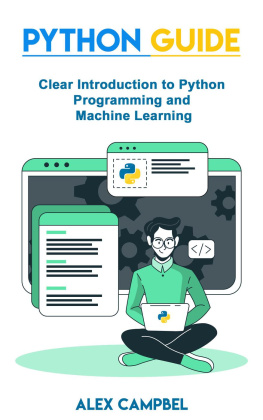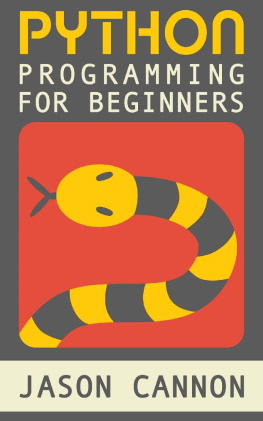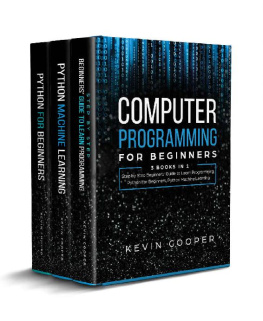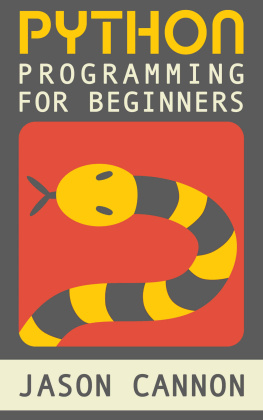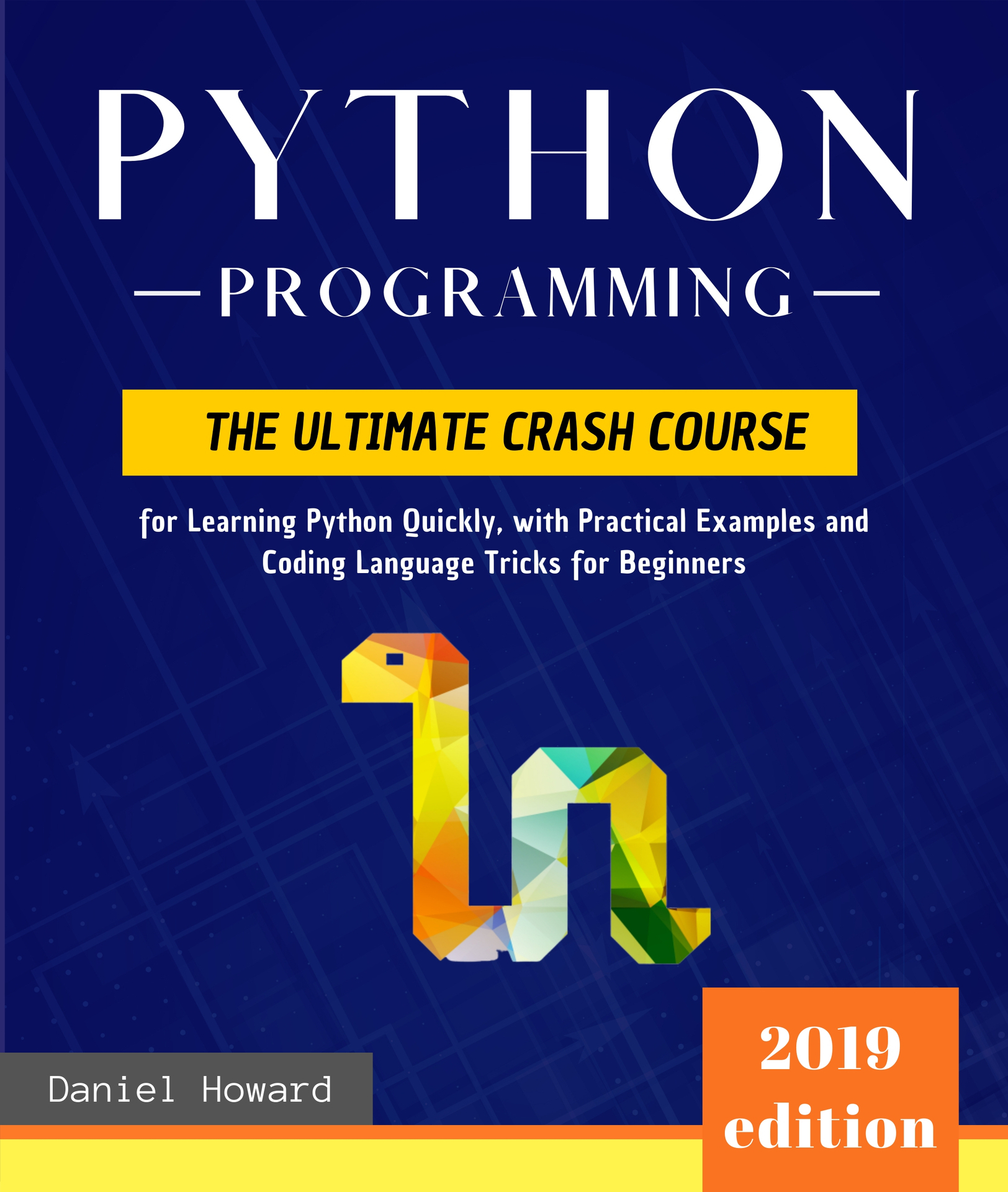Python Programming
The ultimate crash course for learning Python quickly, with practical examples and coding language tricks
for beginners.
Computer programming for data science and machine learning.
Table of Contents
Introduction
Congratulations on purchasing Python Programming, and thank you for doing so.
The following chapters will discuss many of the different topics that you need to know when it is time to learn how to work with the Python programming language. There are a lot of companies and individuals who want to be able to learn how to code, and the Python language is going to be one of the best options for you to choose to go with. This guidebook will make sure that you are able to get some of the basics of this process down, so you can write your own codes down in no time, no matter what you would like to use these for.
To start, this guidebook is going to take a look at some of the basics that come with Python. We are going to spend some time looking at the benefits of working with Python and why it is such a good language to work with, and then we will spend some time exploring what this language takes to get installed on the various different operating systems that are out there. From there, we can look at a few of the basic parts that come with this code, including the objects, comments, keywords, functions, and more.
Now that some of those basics are out of the way, it is time for us to take a look at some of the coding that we are able to do when it is time to work with this language. The best way to learn anything about coding and how to make this happen, we first need to look at some of the codes and get some practice with those. Here we are going to learn how to work with the different data types that are there, how to work with the functions, the importance of classes in the Python language, and how to write out some of our own conditional statements. All of these are going to provide us with some really great codes that we are able to write with the help of the Python language.
After we have had some time to learn those different parts of the coding world, it is time to look at some of the tips and tricks that we are able to do when it comes to learning how to code. No matter how much we prepare, there are times when things are not going to work the way that you want. These tips are going to show you some of the things that you can do when your code is not behaving the way that it should.
The end of this guidebook is going to spend some time looking at the basics of data analysis and why this is an important part of the process. Many companies are jumping on board and looking at how to work with data science and data analysis easier than ever before. You will quickly be able to keep up with the benefits of working with this, the different steps that you need to take in order to work with a data analysis for your own projects, and some of the best algorithms that we are going to be able to work with when it comes to the Python language and data analysis.
There is so much that we are able to work in order to get started with the Python language, and this guidebook will spend some time talking about the most important parts of this process so that you are able to make it work for all of your business need. When you are ready to learn more about Python programming and how you can work with this on data science or a data analysis project, make sure to check out this guidebook to get started!
Every effort was made to ensure it is full of as much useful information as possible; please enjoy it!
Chapter 1: What is the Python Language, and Why Should I Use It?
There are a lot of different coding languages out there that we are able to work with. We may find that some of these are going to work the best when they help us create webpages and work online. Others are going to be able to handle some of the more technical aspects of our work, whether we are working with math or science, and can tell us a lot about the world, the trends around us, and more. And still, others are able to be there to help a beginner get into the world of coding.
If you are just getting started with the idea of coding, then the best option that you can choose to learn how to code is with the Python language. This language is simple to learn while having all of the features and power that you need to get coding done. This language is going to come with the standard library and plenty of extensions to get the work completed. And as we go through this guidebook, you will quickly see why this language is actually pretty easy for you to learn, even as a beginner.
There are a lot of programmers out there who love to work with the Python language and wouldnt choose anything else to work with for their coding needs. And this could easily become you with a little bit of knowledge and practice along the way. when you are ready to learn a bit more about the Python language and how it works, make sure to check out the rest of this guidebook to see what we are talking about!
How to Use Python
While we are here, we need to spend some time taking a look at some of the major uses that come with the Python language. Many companies are more than willing to learn how to work with the Python language for some of their big computer tasks. You will find that Python is already making a bit different in some of the methods that companies use to work well, and towards making sure that the bottom line is not going to bottom out in the process. Here are some of the different ways that we are able to work with the Python language in order to see just all of the capabilities that can come with this language.
The first way that we are able to work with Python is to help us to develop some applications. This can include things like a software development application, network programming, games, web applications, GUI based applications, and more. This is due to the fact that Python is able to make an interface that is interactive and is easy to develop applications with.
Python is also going to be able to help out with multiple programming paradigms. Python is going to provide us with some of the support that is needed to handle these. As it is able to support OOP, as well as support for structured programming, Python is going to come with a bunch of features that allow it to support the concepts and more that comes with a functional programming language. We are able to use this language to help out with a system that is dynamic, and even with automatic management of the memory.
We will also see that Python is going to have a robust and fairly large library that is going to be useful for developing any applications that you would like. It is also going to make it easier for a developer to rely more on Python compared to the other languages as well. The standard Python library is going to help us use a different range of modules that are available so that we can complete any of the tasks that you would like.
Next on the list is that the Python language is going to be compatible with a lot of major systems and platforms. This is going to make it easier for us to complete a lot more projects because we will be able to finish them no matter what platform or system we are working with. Python is going to be so compatible because it is used mainly for developing some new applications.
With the help of the interpreter, the code is going to be run on the right platform, and it has the tools that are needed to support most of the major operating systems that are out there. this makes it easier to pull up the programs and more that come with Python and get them to work no matter what you plan to do with them or where they need to work.








